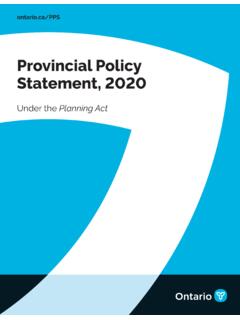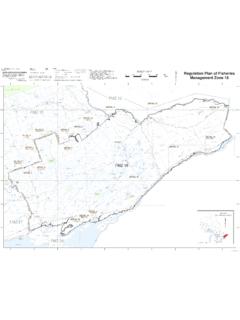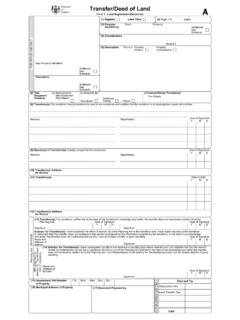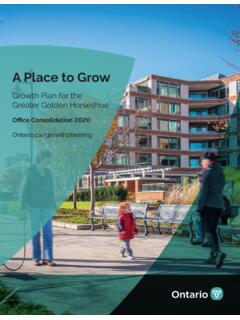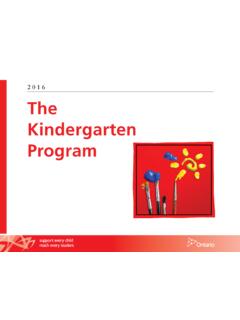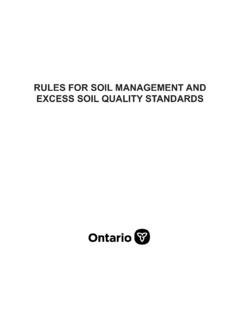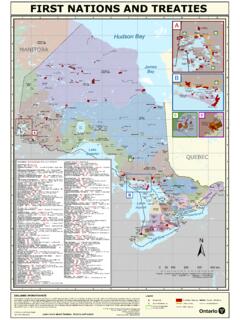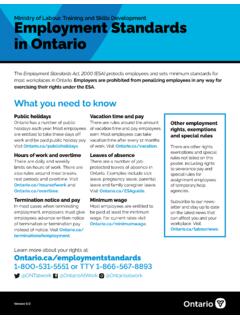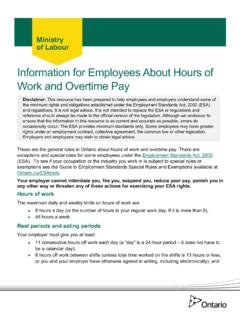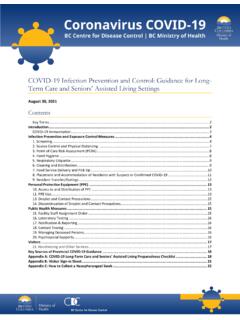Transcription of Living with and Managing COVID-19
1 Living with and Managing COVID-19 . Technical Media Briefing Ministry of Health March 9, 2022. Overview With the peak of Omicron behind us, Ontario has been able to cautiously and gradually move through its reopening milestones. The majority of public health and workplace safety measures have now been lifted, and key public health indicators continue to improve or remain stable. Thanks to our high vaccination rates as well as the arrival of antivirals, Ontario has the tools necessary to manage the impact of this virus, and we are now learning to live with and manage COVID-19 for the long-term. This necessitates a shift to a more balanced response to the pandemic, and changes are being made with respect to the province's pandemic response to reflect a longer- term approach. The following slides speak to how Ontario intends to lift the remaining public health and workplace safety measures as well as track key indicators going forward.
2 2. Ontario's Reopening Plan Following the peak of the Omicron wave, on January 20, 2022, the government released details of its steps to cautiously and gradually ease public health and workplace safety measures, starting on 100%. January 31, 2022. All settings may open Proof of vaccination, capacity Continued improvements in key at full (100%) capacity limit, and physical distancing requirements lifted in all settings. indicators have allowed the province to continue to ease public health measures sooner, with the majority of COVID-19 related public health and workplace safety measures lifted on March 1, 2022. No limits on indoor Sector-specific restrictions or outdoor social gatherings such as limits on dancing or singing, and organized public events requirements to remain seated, or religious services, rites, requirements for appointments/. or ceremonies. reservations, and active screening, etc.
3 Lifted. 3. Ongoing Improvements in Key Indicators Per cent positivity remained COVID-19 hospitalizations The average for new COVID- The number of wastewater stable this past week at have decreased of 81% related admissions to ICU in sites in the province reporting (February 20 to February 26, compared to January peak the last week was 15 patients a downward trend in SARS- 2022). Per cent positivity was (4190; January 16, 2022). per day, which is a decrease CoV-2 detections has started at its highest on January 2, The average for new COVID+ of 77% from the week of to decrease; with an increase 2022 at admissions to hospital in the January 10-16 (average was in the number of sites last week was 82 patients per 65). demonstrating a stable trend. day, which is a decrease of It is normal to see fluctuating 79% from the week of January wastewater trends. 10-16 (average was 390). 4. CMOH Directives & Letter of Instructions The Chief Medical Officer of Health has issued seven Key Principles Directives to health care providers and health care entities Moving away from emergency measures to ongoing currently in place detailing precautions and procedures with operations respect to COVID-19 .
4 Moving away from reliance on provincial direction In addition, instructions were also issued by the CMOH through mandatory requirements requiring a COVID-19 vaccination policy in a number of high- risk settings ( the education sector, retirement homes, Endeavouring to bring as much as possible community care and post-secondary institutions) consistent guidance , both across and within sectors;. A process is now underway to gradually revoke all CMOH Ensuring supports for most vulnerable are removed Directives and instructions by the end of April. In all cases, last Directives will be replaced with operational guidance or recommendations from the CMOH and relevant ministry. Providing sufficient time for sectors to prepare Ontario's Chief Medical Officer of Health remains As Directives are revoked, individual key decision maker on Directives and LOIs. organizations will continue to have the Decisions on revoking pandemic related authority to keep requirements in place.
5 Requirements (Directives or Letters of Instruction,). continue to be evidence based and informed by Personal protective equipment and rapid indicators and trends. antigen tests will continue to be provided to support health and safety in these settings. Lifting of measures are undertaken in a coordinated fashion. 5. CMOH Directives & Letter of Instructions (cont.). As Directives are revoked, individual organizations will continue to have the authority to keep requirements in place. Personal protective equipment and rapid antigen tests will continue to be provided to support health and safety in these settings. Date What's Changing? Ongoing Support March 14: Revoke Directive 6 Province to continue providing rapid-antigen Mandatory vaccination Revoke letters of instruction to Ministry of Children, Community and tests to organizations policies end Social Services, Ministry of Seniors and Accessibility and Ministry of Organizations can retain their own policies Education Revoke Minister of Long-Term Care directive on immunization policy March 21.
6 Remove masking requirements in most places (including schools), Province to continue providing rapid-antigen Most masking except public transit, long-term care, retirement homes and other tests and PPE to schools and businesses mandates end health-care settings, shelters, jails and congregate care and Living Individuals can continue to opt to wear masks settings, including homes for individuals with developmental disabilities Lift other measures in schools, including removing cohorting and daily Enhanced cleaning, optimizing air quality and ventilation and absence reporting will remain on-site screening in schools All other regulatory requirements for businesses removed, including passive screening, safety plans March 28: Reopening Ontario Act (ROA) expires Final extension of ROA emergency order for Reopening Ontario Act 30 days expires April 27: Remove masking requirements in all remaining settings CMOH guidance and recommendations on All remaining Any remaining emergency orders under ROA expire IPAC, including use of PPE.
7 Measures, directives Revoke Directives 1, , 3,4 and 5 Province to continue providing rapid-antigen and orders end tests and PPE. 6. Case and Contact Management & Isolation Due to the unique characteristics of the Omicron variant, case and contact management and isolation guidelines are being updated to minimize the burden to workers and families, while ensuring that our highest risk settings continue to be protected. We are able to make these changes due to the availability of rapid tests and the province's high vaccination rate. Current New guidance No isolation requirements for any groups. For 10 days after exposure, all close contacts should: Isolation Fully vaccinated individuals do not need to isolate Self-monitor for symptoms requirements for Unvaccinated/immunocompromised individuals non-household Wear a mask and avoid activities where mask removal would be need to isolate for 10 days (or 5 days if under 12).
8 Necessary close contacts Individuals who have tested positive in past 90 days, Not visit anyone who is at higher risk of illness ( seniors). exempt from isolation Not visit or attend work in highest risk settings (unless they have previously tested positive in past 90 days). The following household members do not need to self-isolate but should follow above precautions for 10 days: Household members that have previously tested positive for Isolation COVID-19 in the past 90 days All household members need to self-isolate while Household members that are 18 + and have received their requirements for the COVID-19 positive case/symptomatic individual booster dose household close is isolating (or for 10 days from last exposure if Household members that are under 18 years old and are fully contacts immunocompromised). vaccinated Household members that do not meet the above criteria must self- isolate as per current requirements.
9 A close contact is anyone you were less than two metres away from for at least 15 minutes, or multiple shorter lengths of time, without personal protective equipment in the 48 hours before your symptoms began or your positive test result, whichever came first. 7. Case and Contact Management & Isolation (continued). Ontario's changes to case and contact management and isolation guidelines ensures that those Living and working in the highest risk settings continue to be protected. We are able to make these changes due to the availability of rapid tests and the province's high vaccination rate. Current New guidance Hospitals (including complex continuing care facilities and paramedic services) and congregate In addition to current eligibility, the following settings are now Highest Risk added to the PCR eligibility list: Setting Definition Living settings, including Long-Term Care, retirement homes, First Nation elder care lodges, Home and community care group homes, shelters, hospices, and correctional provincial Demonstration Schools and hospital schools institutions Highest Risk Cases and contacts who live in highest risk Setting guidance Sector specific guidance will be released to allow for shorter settings must complete 10 days isolation and self-isolation for residents who are contacts quarantine Recommendations for Cases/ All immunocompromised individuals should isolate for 10 days Symptomatic Self isolate for 20 days if severely but follow additional precautions ( , masking, avoiding highest individuals who immunocompromised risk settings and vulnerable individuals) for an additional 10 days are Immune (20 days total).
10 Compromised 8. Updates to COVID-19 Data Reporting (1 of 6). As Ontario continues to ease public health measures and begins to manage COVID-19 for the long-term, the province will be making changes to data reporting starting March 11, 2022. The province is providing additional context for certain indicators to reflect the emergence of Omicron as the dominant variant, and the province's high vaccination rates. Changes to testing guidelines as a result of the highly transmissible Omicron variant have resulted in some indicators becoming less relevant. Additional changes effective March 11, 2022. Death by fatality type (COVID was cause of death, COVID contributed to death, cause of death unknown or missing). Additions &. Deaths by vaccination status and age group Enhancements Removal of deaths known to be not related to COVID from reported death ( , remove deaths that are classified as 'COVID was unrelated to cause of death').
